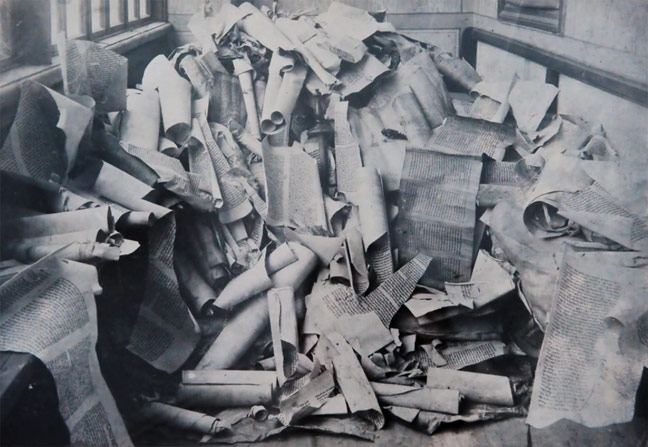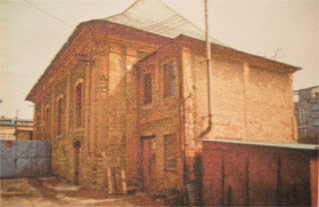Congregation B'nai Jacob Holocaust Torah
Congregation B’nai Jacob’s Holocaust Torah is from the small Czechoslovakian town of Rokycany

A Torah is a scroll of parchment inscribed with the Five Books of Moses. Congregation B’nai Jacob’s Torah, a survivor of the Holocaust, came from Bohemia in the Czech Republic. One hundred and forty thousand artifactswere gathered from 153 communities in Bohemia and Moravia by the Nazis and catalogued by Jewish curators before the curators were sent to their deaths. By the end of the war, these artifacts filled eight historic buildings and many warehouses.
The Nazis fancied themselves as apostles of culture. They contemplated a permanent exhibition of the works of “an extinct ethnographic group”. The Czechoslovakian State Museum in Prague became the home of a collection of Jewish ceremonial objects including 1,564 Sifre Torah from the decimated synagogues of Bohemia, Moravia, and Slovakia.
After the war, the Jewish treasure remained in Prague, however, the decimated Jewish community was helpless to do anything about it. Although most of the objects were beautifully displayed, the Sifre Torah proved to be somewhat of an embarrassment. The Communist Czechoslovakian State, which had taken over the Museum, left the Torahs piled in the unused Michle Synagogues for more than 20 years. The original handling and transporting of the Torahs by the Nazis caused damage; more damage was done by the long period of storage. For nearly twenty years after the war, no alternative to the continued storage and deterioration of the Torahs was found. The only authorities that possessed the will and means to handle this challenge would be found outside of the “Iron Curtain”. Attempts from “the West” were made, but the Czechoslovakian authorities were reluctant to do business with capitalist agents, whom they thought might exploit the enterprise for profit.
Saving the Torahs
Mr. Eric Estorick, the well-known London art dealer who had a great deal of success in showing paintings and sculpture from communist countries, was able to gain the confidence of Artia, the official agents of the Czechoslovakian Government for Cultural Properties. In 1963, he negotiated with them for the purchase of the Sifre Torah. Mr. Estorick secured the patronage of the London philanthropist, Mr. Ralph Yablon, to supply the funds for the purchase and packing, arranged for an expert, Mr. Chimon Abramsky, to investigate the treasure, and engaged experienced packers to transport the Torahs. With Mr. Estorick’s approval, the patron, Mr. Yablon, offered the Torahs to the Westminster Synagogue, which solemnly accepted them. They immediately set up a Memorial Scrolls Committee (http://www.memorialscrollstrust.org/).
Arrival in Westminster

On February 7,1964, the largest shipment of Sifre Torahs in history arrived at their destination in Westminster. e rooms in the synagogue, shelves were erected and numbered providing one space for each of the 1,564 Torahs. The task of giving each of the Torahs a number took several months. The following summer, the second stage, the work of examining and classifying the Torahs began. Several skilled scribes inspected each Torah from beginning to end and made entries of their findings regarding the condition of the parchment, writing, and of any noteworthy distinguishing features.
After separating the Torahs by their condition, it was proposed that a certain number be distributed. Hundreds of requests were received from all over the globe. The patron requested that some be kept at the Westminster Synagogue as a permanent memorial and some of those with special historic interest be given to museums. The majority of them were allotted to synagogues in Britain and in lands abroad, wherever, in the judgment of the Committee, the need was greatest.
Our Sefer Torah
All of the Torahs that could be made kosher were distributed. The remainder, like ours, is being allocated to congregations that wish to have a memorial to the martyred communities. After the Committee approves a request, a Torah is handed over on “permanent loan”. Each Torah bears a brass plate with a number corresponding to the number on a certificate that describes the origin of the Torah and any known particulars.

Congregation B’nai Jacob’s Torah comes from a small town in Czechoslovakia in western Bohemia called Rokycany, which is a short distance from the city of Pilsen. Pilsen was one of the earliest Jewish communities in Bohemia. The first documentary record is the decree of 1338 signed by Charles IV in which the city’s administrators ordered, under penalty, to protect the Jews from molestation. In 1432, the Jewish community built a synagogue and bought a plot of land for a cemetery. In 1504, Jews were expelled from Pilsen as a result of a Host desecration charge (blood libel). From then until 1848, Jews lived in surrounding villages and did their business in the town. It was about this time that Jews settled in Rokycany. A prayer room was established in a house in 1871. A cemetery was found there from the end of the 19th Century.
On September 1,1941, the Germans issued an order forcing Jews to wear yellow badges, which resulted in their complete isolation. Efforts were made to promote legal and illegal Jewish emigration. By the time that emigration was totally banned, 26,629 persons had succeeded in escaping from the country. On October 10,1941 in a secret meeting at the Prague castle, the Germans ordered the Jewish communities to concentrate all the Jews living in their respective areas into a number of cities. The Jews of Rokycany would have been expected to go to Prague. In October and November 1941, 6,000 Jews from Prague and Brno were deported directly to Lodz and Minsk. In the period from November 24, 1941-March 16,1945, 73,614 Jews were dispatched to Theresienstadt. From January 9,1942 to October 28,1944, 60,399 Czechoslovakian Jews were deported onward from Theresienstadt to the extermination camps in the East- Auschwitz, Majdanek, Minsk, Riga, Sobibor, Treblinka and Zamosc. Only 3,227 of the Jews deported rvived the war, It is estimated that out of the 356,830 Jews living in Czechoslovakia in 1939, less than a sixth remained in the country in 1948.
On December 2, 1995, Steven and Jane Corbman, members of B’nai Jacob, formally presented the Rokycany Holocaust Torah to our Congregation. Dr. William Margolis. also a member, provided the case to display it on our Bimah so that it may be seen and used as a living memorial to the Jews of Rokycany and all the other Jewish communities that were ravaged and slain in the Holocaust.
